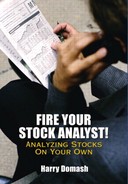Company-Specific Risks Described in Subsequent Chapters
Here are company-specific risk factors described in more detail in Part 2.
Financial Health
Company failure is the most disastrous stock ownership risk that you face. Shareholders typically lose their entire investment when a company files bankruptcy. Don't even think about buying a stock without first checking its financial health to make sure that it's not a bankruptcy candidate. You will learn how in Chapter 10.
Business Plan/Growth by Acquisition
Some companies are better investment prospects than others because they have superior business plans. They may address markets with little competition, produce products seen as superior by consumers, have better distribution methods, and so on.
You can't assume that a firm has a viable business plan just because it's publicly traded and analysts are recommending buying its stock. The dot-com bust illustrated that given the right circumstances, firms with little chance of success can raise billions of dollars from gullible investors, both amateur and professional.
An especially important factor of a company's business plan is its growth strategy. Most firms grow by developing new products, opening new stores, and so forth. However some resort to an acquisition strategy to maintain growth after they've saturated their original markets. Early successes implementing this strategy lead to overconfidence. Eventually the company makes a bad acquisition, its results fall short of expectations, and the shortfall sinks its share price. Since it was issuing shares to pay for the acquisitions, the lower stock price devalues its acquisition currency, further slowing growth which puts more pressure on the share price.
Chapter 8 describes how to evaluate a business plan, including how to spot companies growing mainly by acquisition. The chapter includes a scorecard for evaluating business plans. Possible scores range from –11 to +11. Candidates with negative scores are riskier than those scoring positive, but a negative score is not by itself a disqualifying factor.
Valuation
The market often bids up profitable companies with intriguing business plans to unrealistic valuations, making them risky investments, despite their strong prospects. Eventually most firms trade at prices reflecting their long-term growth prospects. You can determine the annual earnings growth rate implied by a stock's current valuation using the methods described in Chapter 5. Few firms grow earnings as much as 40 percent annually for sustained periods, and most don't achieve anywhere near that rate. Consider stocks with implied earnings growth of 30 percent or higher as risky bets, but high valuation by itself is not necessarily a disqualifying factor.
Faltering Growth/Creative Accounting
Young companies exploiting emerging market opportunities often experience explosive growth in their early years. The market expects that growth to continue indefinitely and prices the firm's shares accordingly. Those early growth rates are unsustainable, and company management sometimes resorts to accounting shenanigans to maintain the illusion of growth when real growth slows. Eventually the house of cards collapses, earnings fall short of expectations, and the stock price crumples. Chapter 12 describes how to spot red flags signaling slowing growth and the accounting shenanigans that frequently mask faltering growth. Avoid stocks showing any red flags.
High Expectations
Unmet expectations lead to disappointment, and the market reacts by hammering the offending company's stock price. The higher the expectations, the more chance of disappointment. Consequently, high expectations equate to high risk. Chapter 4 describes how to calculate a Sentiment Index score based on analysts' buy/sell recommendations. Sentiment Index values of 9 or higher indicate risk, but high Sentiment Index scores alone are not a disqualifying factor.
